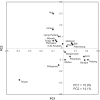A mitochondrial stratigraphy for island southeast Asia
- PMID: 17160892
- PMCID: PMC1876738
- DOI: 10.1086/510412
A mitochondrial stratigraphy for island southeast Asia
Abstract
Island Southeast Asia (ISEA) was first colonized by modern humans at least 45,000 years ago, but the extent to which the modern inhabitants trace their ancestry to the first settlers is a matter of debate. It is widely held, in both archaeology and linguistics, that they are largely descended from a second wave of dispersal, proto-Austronesian-speaking agriculturalists who originated in China and spread to Taiwan approximately 5,500 years ago. From there, they are thought to have dispersed into ISEA approximately 4,000 years ago, assimilating the indigenous populations. Here, we demonstrate that mitochondrial DNA diversity in the region is extremely high and includes a large number of indigenous clades. Only a fraction of these date back to the time of first settlement, and the majority appear to mark dispersals in the late-Pleistocene or early-Holocene epoch most likely triggered by postglacial flooding. There are much closer genetic links to Taiwan than to the mainland, but most of these probably predated the mid-Holocene "Out of Taiwan" event as traditionally envisioned. Only approximately 20% at most of modern mitochondrial DNAs in ISEA could be linked to such an event, suggesting that, if an agriculturalist migration did take place, it was demographically minor, at least with regard to the involvement of women.
Figures






References
Web Resources
-
- Fluxus-engineering.com, http://www.fluxus-engineering.com/sharenet.htm (for Network 4 software package)
-
- GenBank, http://www.ncbi.nlm.nih.gov/Genbank/ (for sequences [accession numbers EF068415–EF069260])
References
-
- Barker G, Barton H, Beavitt P, Bird M, Daly P, Doherty C, Gilbertson D, Hunt C, Krigbaum J, Lewis H, et al (2002) Prehistoric foragers and farmers in southeast Asia: renewed investigations at Niah Cave, Sarawak. Proc Prehist Soc 68:147–164
-
- Détroit F, Dizon E, Falguères C, Hameau S, Ronquillo W, Sémah F (2004) Upper Pleistocene Homo sapiens from the Tabon cave (Palawan, The Philippines): description and dating of new discoveries. C R Palevol 3:705–71210.1016/j.crpv.2004.06.004 - DOI
-
- Voris HK (2000) Maps of Pleistocene sea levels in Southeast Asia: shorelines, river systems and time durations. J Biogeogr 27:1153–116710.1046/j.1365-2699.2000.00489.x - DOI
-
- Bellwood P (1997) Prehistory of the Indo-Malaysian archipelago. University of Hawaii Press, Hawaii
-
- Oppenheimer S (1998) Eden in the East. Wiedenfeld and Nicholson, London
Publication types
MeSH terms
Substances
LinkOut - more resources
Full Text Sources
Molecular Biology Databases

